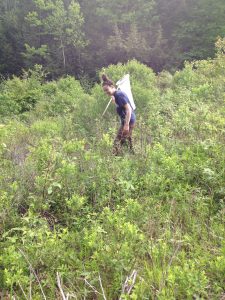Can Maine’s Native Bees Be the State’s Top Pollinator?
 With commercial honeybees dying off and prices for their pollinating services threatening to rise, UMaine researchers are taking a closer look at Maine’s native bees.
With commercial honeybees dying off and prices for their pollinating services threatening to rise, UMaine researchers are taking a closer look at Maine’s native bees.
Blueberry growers have been wary of depending on these local pollinators. They’re hard to get a handle on. Unlike honeybees, which live in manufactured hives up to 70,000 insects deep, native bees live in small groups or alone. They burrow into the ground. They camp out in hollow trees. They may nest in the insulation right inside your house.
A team working on a grant from UMaine’s Senator George J. Mitchell Center for Sustainability Solutions is working to increase blueberry growers’ interest in and understanding of native bee conservation and use. A new tool kit helps them better understand and manage the native bees on their land
“We haven’t used wild bees systematically,” said Sam Hanes, Assistant Professor of Anthropology and the team’s leader. “People are interested. It’s a matter of trying to maximize the bees’ usefulness.”
Hanes and colleagues want to help growers big and small look at native bees with fresh eyes. Maine blueberry growers now bring in around 80,000 honeybee hives from out of state annually at about $100 a rental. The U.S. honeybee population has declined by 40 percent since 1980 due to several reasons, including a mite pathogen and Colony Collapse Disorder.
Project research assistant and PhD student Brianne Du Clos is interviewing Maine blueberry growers big and small to get their input on a habitat assessment tool she is designing. It’s part of a novel tool kit for growers designed by the research team. It includes:
- A prototype of a geographic information system (GIS) tool that Du Clos is developing with input from growers. Using data gathered by UMaine graduate student Shannon Chapin Groff combined with satellite information, growers will be able to better assess their native bee habitat.
- A video demonstrating how to assess the size of native bee populations in the field.
- A plant list for growers who want to provide bee habitat.
- A budget tool that helps growers estimate the economics of native bee use and conservation.
During the winter and early spring, Du Clos will be meeting with focus groups of growers to refine data for the GIS tool. Du Clos, Hanes and team members know growers don’t have a lot of time to traverse their property seeking out and identifying bees on their own.
There’s so much to learn, Du Clos notes, such as: “we know that coniferous forest does not contain as many bees as deciduous forest or wetlands do. This information can help wild blueberry growers make decisions about pollination management and conservation on and around their crop fields”.
She will present a more finalized version of the GIS tool to growers at the Wild Blueberry Summer Field Day in July 2015 in Jonesboro, the largest annual meeting of blueberry growers in Maine.
The kit provided by the research team and knowledge imparted at meetings give growers new options. Already, says Hanes, it is estimated that native bees are responsible for 25 percent of blueberry crop pollination. Strategic steps by farmers will likely improve that percentage.
For example, a clear cutting of pine forest allows wildflowers to grow and offers native bees like the leafcutters and miners – not to mention the super pollinator bumble bee – a cross-fertilization haven.
Said Hanes: “We’re ahead of the curve in trying to provide these tools and information to growers.”
